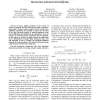Free Online Productivity Tools
i2Speak
i2Symbol
i2OCR
iTex2Img
iWeb2Print
iWeb2Shot
i2Type
iPdf2Split
iPdf2Merge
i2Bopomofo
i2Arabic
i2Style
i2Image
i2PDF
iLatex2Rtf
Sci2ools
DICTA
2009
2009
Multivariate Skew t Mixture Models: Applications to Fluorescence-Activated Cell Sorting Data
In many applied problems in the context of pattern recognition, the data often involve highly asymmetric observations. Normal mixture models tend to overfit when additional components are included to capture the skewness of the data. Increased number of pseudo-components could lead to difficulties and inefficiencies in computations. Also, the contours of the fitted mixture components may be distorted. In this paper, we propose to adopt mixtures of multivariate skew t distributions to handle highly asymmetric data. The EM algorithm is used to compute the maximum likelihood estimates of model parameters. The method is illustrated using a flurorescence-activated cell sorting data. Keywords-Asymmetric multivariate data; EM algorithm; fluorescene-activated cell sorting; mixture models; skewed t.
| Added | 09 Nov 2010 |
| Updated | 09 Nov 2010 |
| Type | Conference |
| Year | 2009 |
| Where | DICTA |
| Authors | Kui Wang, Shu-Kay Ng, Geoffrey J. McLachlan |
Comments (0)

